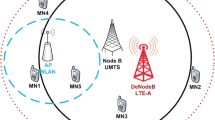Abstract
Multi-objective tree models are used to optimize more than one objective function. This mathematical approach focuses on decision-making models and are particularly suitable for wireless networks (i.e., decisions are taken between two or more conflicting objectives). In particular, a wireless network’s operation is based on multiple constraints (e.g., increased throughput requires higher-channel bandwidth and improved security requires complex key generation). In general, low bandwidth wireless networks suffer to provide better quality of service (QoS) and improved security. To achieve these multiple outcomes, a multi-objective optimization problem is analysed mathematically in this work. To the best of our knowledge, no other works deal with a multi-objective tree model for wireless denial of service problems with improved QoS.










Similar content being viewed by others
References
Zhang, D., Gogi, S. A., Broyles, D. S., Cetinkaya, E. K., & Sterbenz, J. P. G. (2012). Modelling attacks and challenges to wireless networks. In 4th international congress on ultra modern telecommunications and control systems and workshops (ICUMT), 2012 (pp. 806–812). IEEE.
Khouzani, M. H. R., Sarkar, S., & Altman, E. (2012). Maximum damage malware attack in mobile wireless networks. IEEE/ACM Transactions on Networking (TON), 20(5), 1347–1360.
Li, L., Zhang, G., Nie, J., Niu, Y., & Yao, A. (2012). The application of genetic algorithm to intrusion detection in MP2P network. In Y. Tan, Y. Shi & Z. Ji (Eds.), Advances in swarm intelligence (pp. 390–397). Berlin: Springer.
Ratna, S. R., Ravi, R., & Shekhar, B. (2013). Mitigating denial of service attacks in wireless networks. International Journal of Advanced Research in Computer Engineering & Technology (IJARCET), 2(5), 1716.
Luo, Z., & Jannett, T. C. (2012). A multi-objective method to balance energy consumption and performance for energy-based target localization in wireless sensor networks. In Proceedings of IEEE Southeastcon, 2012 (pp. 1–6). IEEE.
Vecchio, M., López-Valcarce, R., & Marcelloni, F. (2012). A two-objective evolutionary approach based on topological constraints for node localization in wireless sensor networks. Applied Soft Computing, 12(7), 1891–1901.
Jiang, C., Shi, Y., Kompella, S., Hou, Y. T., & Midkiff, S. F. (2012). Bicriteria optimization in multi-hop wireless networks: Characterizing the throughput-energy envelope. IEEE Transactions on Mobile Computing, 99(1), 1–12.
Wang, Q., Jaffrès-Runser, K., Goursaud, C., & Gorce, J.-M. (2012). Deriving Pareto-optimal performance bounds for 1 and 2-relay wireless networks. arXiv:1211.3250 (arXiv preprint).
Burchardt, H., Sinanovic, S., Auer, G., & Haas, H. (2012). Pareto optimal SINR scheduling for femto-cell deployment in wireless networks. In Vehicular technology conference (VTC fall), 2012 IEEE (pp. 1–5). IEEE.
Seo, D., Lee, H., & Perrig, A. (2013). APFS: Adaptive probabilistic filter scheduling against distributed denial-of-service attacks. Computers & Security, 39, 366–385.
Rastegari, S., Hingston, P., Lam, C.-P., & Brand, M. (2013). Testing a distributed denial of service defence mechanism using red teaming. In IEEE symposium on computational intelligence for security and defense applications (CISDA), 2013 (pp. 23–29). IEEE.
Tan, Z., Nanda, P., Liu, R. P., Jamdagni, A., & He, X. (2013). A system for denial-of-service attack detection based on multivariate correlation analysis. IEEE Transactions on Parallel and Distributed Systems, 99(1), 1.
Vigo, R., Nielson, F., & Nielson, H. R. (2013). Broadcast, denial-of-service, and secure communication. Integrated formal methods (pp. 412–427). Berlin: Springer.
Raghunath, A., Ramachandran, S., Subramanian, S., & Vaidyanathan, S. (2013). Data rate based adaptive thread assignment solution for combating the slow POST denial of service attack. ACM SIGSOFT Software Engineering Notes, 38(5), 1–5.
Arumugam, N., & Venkatesh, C. (2013). Ant system algorithm based Ip Traceback method to detect denial of service attack on data network. Australian Journal of Basic & Applied Sciences, 7(7), 70–78.
Chaudhari, S., Lunden, J., Koivunen, V., & Poor, H. V. (2012). Cooperative sensing with imperfect reporting channels: Hard decisions or soft decisions? IEEE Transactions on Signal Processing, 60(1), 18–28.
Batalla, J. M., Beben, A., & Chen, Y. (2012). Optimization of the decision process in NEtwork and server-aware algorithms. In XVth international telecommunications network strategy and planning symposium (NETWORKS), 2012 (pp. 1–6). IEEE.
Barros, R. C., Basgalupp, M. P., de Carvalho, A. C. P. L. F., & Freitas, A. A. (2012). A survey of evolutionary algorithms for decision-tree induction. IEEE Transactions on Systems, Man, and Cybernetics Part C: Applications and Reviews, 42(3), 291–312.
Author information
Authors and Affiliations
Corresponding author
Rights and permissions
About this article
Cite this article
Duraipandian, M., Palanisamy, C. Analysis of a Combined Parameter-Based Multi-objective Model for Performance Improvement in Wireless Networks. Wireless Pers Commun 83, 2425–2437 (2015). https://doi.org/10.1007/s11277-015-2536-6
Published:
Issue Date:
DOI: https://doi.org/10.1007/s11277-015-2536-6




